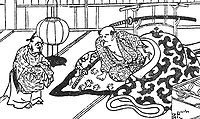Zashiki-warashi
You can help expand this article with text translated from the corresponding article in Japanese. (May 2016) Click [show] for important translation instructions.
|

The Zashiki-Warashi (Japanese: 座敷童 or 座敷童子, literally "guestroom child") sometimes also called Zashiki Bokko (Japanese: 座敷ぼっこ, literally "guestroom basker") is a Yōkai (Japanese: 妖怪, variously translated as "ghoul" or "goblin") originating from Iwate Prefecture.[1]
It is similar to the Russian folk story of the Domovoi.
Etymology
The name breaks down to zashiki (Japanese: 座敷), a sitting room or parlor, usually with tatami flooring, and warashi (Japanese: 童子), an archaic term for a child, used particularly in the northeast of Japan.[2][3]
Description
The appearance of this spirit is that of a 5 or 6 year child with bobbed hair and a red face.[4] Zashiki warashi can be found in well-maintained and preferably large old houses.[5] It is said that once a zashiki warashi inhabits a house, it brings the residence great fortune; on the other hand, should a zashiki warashi depart, the domain soon falls into a steep decline.[6]
As the zashiki warashi is child-like in nature, it is prone to playing harmless pranks and occasionally causing mischief. They are known for running around and making noise, even adjusting the bedding of overnight guests.[7] Sometimes they leave little footsteps in ashes. There are different variations as to who can see the zashiki warashi; usually this is limited to inhabitants of the house, sometimes to children.[8]
Yōkai similar to zashiki warashi in other parts of Japan include: the makuragaeshi in Ishikawa Prefecture - another creature which alters bedding;[9] the ainukaisei in Hokkaido; and the akagantā found in Okinawa.[10]
The Ryokufūsō in Kindaichi-Onsen, which burned down on October 4, 2009, was famed for its zashiki warashi.[11]
In popular culture
- In the manga and anime xxxHolic, the zashiki warashi is represented as a character who developed feelings for the protagonist Kimihiro Watanuki.
- In the anime Mononoke, zashiki warashi were represented by the spirits of fetus that were aborted by the prostitutes in a brothel.[12]
- In the manga Nura: Rise of the Yokai Clan - Demon Capital/Nurarihyon no Mago (Sennen Makyou), there is a zashiki warashi named Yukari.
- In the Super Sentai series Ninja Sentai Kakuranger, Zashiki-warashi is a minor monster of the day who refuses to fight for the Youkai Army Corps and befriends a group of kids and Ninja Black. He is under an evil spell until he manages to break free only to be killed by Gashadokuro and turns into a mushroom. He appears in Mighty Morphin Alien Rangers, and Power Rangers Zeo as Bratboy who in Alien Rangers is the monster form of Farkas "Bulk" Bulkmeier and in Zeo has a cameo in Prince Gasket's Arena.
- in the anime Hetalia, a zashiki warashi appeared as a giggling spirit. When England had a sleepover at Japan's house he heard her voice and chased her, but when he told Japan what had happened, Japan replied that he lives alone.
- In the game and anime Yo-Kai Watch the Zashiki-warashi appear as helpers that involve themselves in everyday lives of humans even though they can't see them.
- In the manga and anime Hoozuki no Reitetsu, two zashiki-warashi are taken in by Hoozuki.
- In the manga and anime Kimi ni Todoke, the main character says that her nickname used to be Zashiki Warashi.
- In the videogame series Pokémon, Snorunt (Japanese: ユキワラシ, Yukiwarashi) appears to be based on these.
Notes
- ^ Takayuki 1996, p. 173-174.
- ^ Matsumura 2006.
- ^ Yoshimura 2015, p. 170.
- ^ Blacker 1963, p. 87.
- ^ Takayuki 1996, p. 173.
- ^ Yoda & Alt 2013, p. 31-32.
- ^ Yoshimura 2015, p. 149.
- ^ Nomura 1987, p. 121.
- ^ Foster & Kijin 2015, p. 236-239.
- ^ Foster & Kijin 2015, p. 239.
- ^ Tsuruta & Fujiyoshi 2016, p. "Zashiki-Warashi Inn" Rebuilt 6 Years and 7 Months after Fire.
- ^ Nakamura 2007.
References
- Blacker, Carmen (1963). "The Divine Boy in Japanese Buddhism". Asian Folklore Studies. 22: 77–88. doi:10.2307/1177563. JSTOR 1177563.
{{cite journal}}: Invalid|ref=harv(help) - Foster, Michael Dylan; Kijin, Shinonome (2015). The Book of Yōkai: Mysterious Creatures of Japanese Folklore. University of California Press. ISBN 978-0-520-27102-9.
{{cite book}}: Invalid|ref=harv(help) - Hamashita, Masahiro (August 2005). "Forests as Seen by Yanagita Kunio: His Contribution to a Contemporary Ecological Idea". Diogenes. 52: 13–16. doi:10.1177/0392192105055166. Retrieved 16 May 2016.
{{cite journal}}: Invalid|ref=harv(help) - Komatsu, Kazuhiko (August–October 1987). "The Dragon Palace Child: An Anthropological and Sociohistorical Approach". Current Anthropology. 28: S31–S39. doi:10.1086/203576. JSTOR 2743426.
{{cite journal}}: Invalid|ref=harv(help) - Matsumura, Akira (2006). Daijirin (3rd ed.). Sanseido Books. ISBN 4385139059.
{{cite book}}: Invalid|ref=harv(help) - Nakamura, Kenji (July 2007). "Zashiki-Warashi". Mononoke. Fuji TV.
{{cite episode}}: Invalid|ref=harv(help) - Takayuki, Tatsumi (December 1996). "Deep North Gothic: a Comparative cultural reading of Hearn, Yanagita and Akutagawa". The Geibun-Kenkyu: Journal of Arts and Letters. 71: 160–183. Retrieved 16 May 2016.
{{cite journal}}: Invalid|ref=harv(help) - Tsuruta, Yusuke; Fujiyoshi, Kyoko (5 May 2016). ""Zashiki-Warashi Inn" Rebuilt 6 Years and 7 Months after Fire". Yomiuri Shinbun Online. Retrieved 16 May 2016.
{{cite web}}: Invalid|ref=harv(help) - Nomura, Junichi (1987). Pocket Encyclopedia of Folktales and Legends. Tokyo: Mizuumi Shobo. ISBN 9784838031085.
{{cite book}}: Invalid|ref=harv(help) - Yoda, Hiroko; Alt, Matt (2013). Yokai Attack! The Japanese Monster Survival Guide. Tuttle Publishing. ISBN 9781462908837.
{{cite book}}: Invalid|ref=harv(help) - Yoshimura, Ayako (2015). "To Believe and Not to Believe: A Native Ethnography of Kanashibari in Japan". Journal of American Folklore. 128: 146–178. doi:10.1353/jaf.2015.0023. Retrieved 16 May 2016.
{{cite journal}}: Invalid|ref=harv(help)
External links
- On Zashiki-Warashi | 百物語怪談会 Hyakumonogatari Kaidankai, by Mizuki Shigeru at hyakumonogatari.com
- The Last of the Zashiki warashi, Awa Life, March 2002
- The Story of Zashiki warashi no geta, Nanbu Kiri Geta Preservation Society
- The Ryokufūsō HOTEL Japan
- Zashiki-warashi: Spooky Japan - Folk Legends - Kids Web Japan - Web Japan
- 133 Yokai Statues on Mizuki Shigeru Road; scroll down to see 67. Zashiki Warashi (Chamber child)
